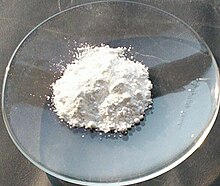സിങ്ക് ഓക്സൈഡ്

| |
| Names | |
|---|---|
| Other names
Zinc white, calamine, philosopher's wool, Chinese white, flowers of zinc
| |
| Identifiers | |
| ChEBI | |
| ChEMBL | |
| ChemSpider | |
| ECHA InfoCard | 100.013.839 |
| EC Number |
|
PubChem CID
|
|
| RTECS number |
|
CompTox Dashboard (EPA)
|
|
| InChI | |
| Properties | |
| തന്മാത്രാ വാക്യം | |
| Molar mass | 0 g mol−1 |
| Appearance | White solid[1] |
| Odor | Odorless |
| സാന്ദ്രത | 5.1 g/cm3[1] |
| ദ്രവണാങ്കം | |
| ക്വഥനാങ്കം | |
| 0.0004% (17.8°C)[2] | |
| Band gap | 3.3 eV (direct) |
| −27.2·10−6 cm3/mol[3] | |
| Refractive index (nD) | n1=2.013, n2=2.029[4] |
| Structure | |
| Wurtzite | |
| C6v4-P63mc | |
a = 3.2495 Å, c = 5.2069 Å
| |
Formula units (Z)
|
2 |
| Tetrahedral | |
| Thermochemistry | |
| Std enthalpy of formation ΔfH |
-350.5±0.3 kJ mol−1 |
| Standard molar entropy S |
43.7±0.4 J·K−1mol−1 |
| Specific heat capacity, C | 40.3 J·K−1mol−1 |
| Hazards | |
| Safety data sheet | ICSC 0208 |
| EU classification | {{{value}}} |
| R-phrases | R50/53 |
| S-phrases | S60, S61 |
| Flash point | {{{value}}} |
| Lethal dose or concentration (LD, LC): | |
LD50 (median dose)
|
240 mg/kg (intraperitoneal, rat)[8] 7950 mg/kg (rat, oral)[9] |
LC50 (median concentration)
|
2500 mg/m3 (mouse)[10] |
LCLo (lowest published)
|
2500 mg/m3 (guinea pig, 3–4 h)[10] |
| NIOSH (US health exposure limits): | |
PEL (Permissible)
|
TWA 5 mg/m3 (fume) TWA 15 mg/m3 (total dust) TWA 5 mg/m3 (resp dust) |
REL (Recommended)
|
Dust: TWA 5 mg/m3 C 15 mg/m3 Fume: TWA 5 mg/m3 ST 10 mg/m3 |
IDLH (Immediate danger)
|
500 mg/m3[7] |
| Related compounds | |
| Other anions | Zinc sulfide Zinc selenide Zinc telluride |
| Other cations | Cadmium oxide Mercury(II) oxide |
Except where otherwise noted, data are given for materials in their standard state (at 25 °C [77 °F], 100 kPa).
| |
ZnO എന്ന രാസസൂത്രമുള്ള ഒരു അകാർബണിക സംയുക്തമാണ് സിങ്ക് ഓക്സൈഡ്. ജലത്തിൽ ലയിക്കാത്ത വെളുത്ത പൊടിയാണ് ZnO, ഇത് റബ്ബർ, പ്ലാസ്റ്റിക്, സെറാമിക്സ്, ഗ്ലാസ്, സിമന്റ്, ലൂബ്രിക്കന്റ്സ്, മരുന്നുകൾ, സുഗന്ധദ്രവ്യങ്ങൾ, സീലന്റ്സ്, പെയിൻറുകൾ, ഭക്ഷണപദാർഥങ്ങൾ, ബാറ്ററികൾ, ഫെറൈറ്റുകൾ, ഫയർ റിട്ടാർഡൻറുകൾ, ഫസ്റ്റ്-എയ്ഡ് ടേപ്പുകൾ തുടങ്ങി നിരവധി വസ്തുക്കളിലും ഉത്പന്നങ്ങളിലും ഒരു അഡിറ്റീവ് ആയി ഉപയോഗിക്കുന്നു. പ്രകൃതിദത്തമായി ഇത് സിൻസൈറ്റ് ധാതു ആയി കാണപ്പെടുന്നുണ്ടെങ്കിലും സിങ്ക് ഓക്സൈഡ് കൂടുതലും കൃത്രിമമായി നിർമ്മിക്കപ്പെടുന്നു. [11]
ഇതും കാണുക[തിരുത്തുക]
അവലംബം[തിരുത്തുക]
- ↑ 1.0 1.1 1.2 1.3 Haynes, p. 4.100
- ↑ NIOSH Pocket Guide to Chemical Hazards. "#0675". National Institute for Occupational Safety and Health (NIOSH).
- ↑ Haynes, p. 4.136
- ↑ Haynes, p. 4.144
- ↑ Takahashi, Kiyoshi; Yoshikawa, Akihiko; Sandhu, Adarsh (2007). Wide bandgap semiconductors: fundamental properties and modern photonic and electronic devices. Springer. p. 357. ISBN 978-3-540-47234-6.
- ↑ Haynes, p. 4.152
- ↑ Zinc oxide. Chem.sis.nlm.nih.gov. Retrieved on 2015-11-17.
- ↑ Zinc oxide. Chem.sis.nlm.nih.gov. Retrieved on 2015-11-17.
- ↑ Haynes, pp. 5.3, 5.16
- ↑ 10.0 10.1 "Zinc oxide". Immediately Dangerous to Life and Health. National Institute for Occupational Safety and Health (NIOSH).
- ↑ De Liedekerke, Marcel (2006) "2.3. Zinc Oxide (Zinc White): Pigments, Inorganic, 1" in Ullmann's Encyclopdia of Industrial Chemistry. Wiley-VCH, Weinheim. doi:10.1002/14356007.a20_243.pub2
Cited sources[തിരുത്തുക]
- Haynes, William M., ed. (2011). CRC Handbook of Chemistry and Physics (92nd ed.). CRC Press. ISBN 978-1439855119.
Reviews[തിരുത്തുക]
- Özgür, Ü; Alivov, Ya. I; Liu, C; Teke, A; Reshchikov, M. A; Doğan, S; Avrutin, V; Cho, S.-J; Morkoç, H (2005). "A comprehensive review of ZnO materials and devices". Journal of Applied Physics. 98 (4): 041301. Bibcode:2005JAP....98d1301O. doi:10.1063/1.1992666.
- A. Bakin and A. Waag "ZnO Epitaxial Growth" (28 pages) Chapter in “Comprehensive Semiconductor Science and Technology“ 6 Volume Encyclopaedia, ELSEVIER, edited by Pallab Bhattacharya, Roberto Fornari and Hiroshi Kamimura, ISBN 978-0-444-53143-8
- Baruah Sunandan (2009). "Hydrothermal growth of ZnO nanostructures". Science and Technology of Advanced Materials. 10 (1): 013001. Bibcode:2009STAdM..10a3001B. doi:10.1088/1468-6996/10/1/013001. PMC 5109597. PMID 27877250.
- Janisch Rebecca (2005). "Transition metal-doped TiO 2 and ZnO—present status of the field". Journal of Physics: Condensed Matter. 17 (27): R657–R689. Bibcode:2005JPCM...17R.657J. doi:10.1088/0953-8984/17/27/R01.
- Heo Y.W. (2004). "ZnO nanowire growth and devices". Materials Science and Engineering: R: Reports. 47 (1–2): 1–47. doi:10.1016/j.mser.2004.09.001.
- Klingshirn C (2007). "ZnO: From basics towards applications". Physica Status Solidi B. 244 (9): 3027–3073. Bibcode:2007PSSBR.244.3027K. doi:10.1002/pssb.200743072.
- Klingshirn C (April 2007). "ZnO: material, physics and applications". ChemPhysChem. 8 (6): 782–803. doi:10.1002/cphc.200700002. PMID 17429819.
- Grace Lu Jia (2006). "Quasi-one-dimensional metal oxide materials—Synthesis, properties and applications". Materials Science and Engineering: R: Reports. 52 (1–3): 49–91. CiteSeerX 10.1.1.125.7559. doi:10.1016/j.mser.2006.04.002.
- Xu Sheng (2011). "One-dimensional ZnO nanostructures: Solution growth and functional properties". Nano Research. 4 (11): 1013–1098. CiteSeerX 10.1.1.654.3359. doi:10.1007/s12274-011-0160-7.
- Xu Sheng (2011). "Oxide nanowire arrays for light-emitting diodes and piezoelectric energy harvesters". Pure and Applied Chemistry. 83 (12): 2171–2198. doi:10.1351/PAC-CON-11-08-17.
പുറം കണ്ണികൾ[തിരുത്തുക]
- Zincite properties
- International Chemical Safety Card 0208.
- NIOSH Pocket Guide to Chemical Hazards.
- സിങ്ക് ഓക്സൈഡ് in the Pesticide Properties DataBase (PPDB)
- Zinc white pigment at ColourLex
